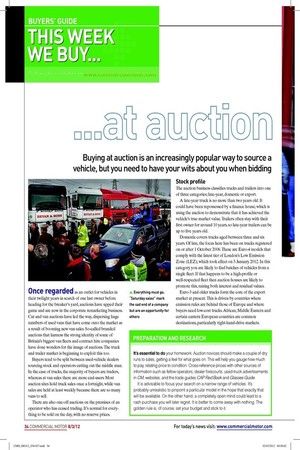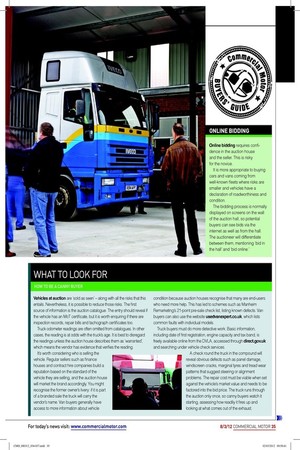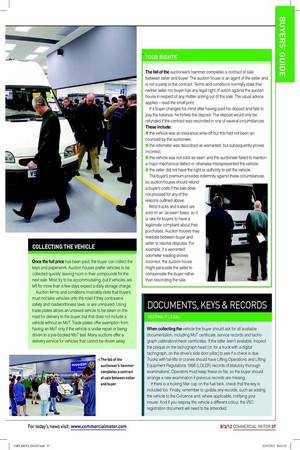THIS WEEK WE BUY...
Page 23

Page 24

Page 25

Page 26

If you've noticed an error in this article please click here to report it so we can fix it.
Buying at auction is an increasingly popular way to source a vehicle, but you need to have your wits about you when bidding
Once regarded as an outlet for vehicles in their twilight years in search of one last owner before heading for the breaker’s yard, auctions have upped their game and are now in the corporate remarketing business. Car and van auctions have led the way, dispersing huge numbers of used vans that have come onto the market as a result of booming new van sales. So-called branded auctions that harness the strong identity of some of Britain’s biggest van leets and contract hire companies have done wonders for the image of auctions. The truck and trailer market is beginning to exploit this too.
Buyers tend to be split between used-vehicle dealers sourcing stock and operators cutting out the middle man. In the case of trucks, the majority of buyers are traders, whereas at van sales there are more end-users. Most auction sites hold truck sales once a fortnight, while van sales are held at least weekly because there are so many vans to sell.
There are also one-off auctions on the premises of an operator who has ceased trading. It’s normal for everything to be sold on the day, with no reserve prices.
Stock profile
The auction business classiies trucks and trailers into one of three categories; late-year, domestic or export.
A late-year truck is no more than two years old. It could have been repossessed by a inance house, which is using the auction to demonstrate that it has achieved the vehicle’s true market value. Trailers often stay with their irst owner for around 10 years, so late-year trailers can be up to ive years old.
Domestic covers trucks aged between three and six years. Of late, the focus here has been on trucks registered on or after 1 October 2006. These are Euro-4 models that comply with the latest tier of London’s Low Emission Zone (LEZ), which took effect on 3 January 2012. In this category you are likely to ind batches of vehicles from a single leet. If that happens to be a high-proile or well-respected leet then auction houses are likely to promote this, raising both interest and residual values.
Euro-3 and older trucks form the core of the export market at present. This is driven by countries where emission rules are behind those of Europe and where buyers need low-cost trucks. African, Middle Eastern and certain eastern European countries are common destinations, particularly right-hand-drive markets.
PREPARATION AND RESEARCH
It’s essential to do your homework. Auction novices should make a couple of dry runs to sales, getting a feel for what goes on. This will help you gauge how much to pay, relating price to condition. Cross-reference prices with other sources of information such as fellow operators, dealer forecourts, used-truck advertisements in CM, websites, and the trade guides CAP Red Book and Glasses Guide.
It is advisable to focus your search on a narrow range of vehicles. It’s probably unrealistic to pinpoint a particular model in the hope that exactly that will be available. On the other hand, a completely open mind could lead to a rash purchase you will later regret. It is better to come away with nothing. The golden rule is, of course, set your budget and stick to it.
ONLINE BIDDING
Online bidding requires confidence in the auction house and the seller. This is risky for the novice.
It is more appropriate to buying cars and vans coming from well-known fleets where risks are smaller and vehicles have a declaration of roadworthiness and condition.
The bidding process is normally displayed on screens on the wall of the auction hall, so potential buyers can see bids via the internet as well as from the hall. The auctioneer will differentiate between them, mentioning ‘bid in the hall’ and ‘bid online.’
WHAT TO LOOK FOR
HOW TO BE A CANNY BUYER Vehicles at auction are ‘sold as seen’ – along with all the risks that this entails. Nevertheless, it is possible to reduce those risks. The first source of information is the auction catalogue. The entry should reveal if the vehicle has an MoT certificate, but it is worth enquiring if there are inspection records, repair bills and tachograph certificates too.
Truck odometer readings are often omitted from catalogues. In other cases, the reading is at odds with the truck’s age. It is best to disregard the readings unless the auction house describes them as ‘warranted’, which means the vendor has evidence that verifies the reading.
It’s worth considering who is selling the vehicle. Regular sellers such as finance houses and contract hire companies build a reputation based on the standard of the vehicle they are selling, and the auction house will market the brand accordingly. You might recognise the former owner’s livery: if it is part of a branded sale the truck will carry the vendor’s name. Van buyers generally have access to more information about vehicle
condition because auction houses recognise that many are end-users who need more help. This has led to schemes such as Manheim Remarketing’s 21-point pre-sale check list, listing known defects. Van buyers can also use the website usedvanexpert.co.uk, which lists common faults with individual models.
Truck buyers must do more detective work. Basic information, including date of first registration, engine capacity and tax band, is freely available online from the DVLA, accessed through direct.gov.uk and searching under vehicle check services.
A check round the truck in the compound will reveal obvious defects such as panel damage, windscreen cracks, marginal tyres and tread wear patterns that suggest steering or alignment problems. The repair cost must be viable when set against the vehicle’s market value and needs to be factored into the bid price. The truck runs through the auction only once, so canny buyers watch it starting, assessing how readily it fires up and looking at what comes out of the exhaust.
AUCTION TACTICS
ESTABLISH EYE CONTACT Some auctions require buyers to first complete a registration form, and in return they will be issued with a bidder’s number and catalogue.
The popular perception is that bidding is best done by lurking at the back of the hall and merely raising an eyebrow. Auction houses advise the opposite: make yourself highly visible to the auctioneer and bid clearly by raising your hand. Establish eye contact with the auctioneer to ensure he sees your bid. It is your choice whether you start bidding from the word go or wait until the price is nearer what you expect to pay. Price increments are wide when the bidding starts – £1,000, £500, or £250. The steps get smaller when bids are nearing their peak. Buyers make a slashing movement with their hands to indicate that they wish to halve the increment.
Bid quickly to secure your target. Auctions move at a pace, so buyers need a clear plan of action and must execute it smartly. Alternatively, buyers can submit a commission bid before the auction. This will be included in the sale and guarantees that you do not exceed your budget in the heat of the moment. Similarly, online bidders can submit a starting price and a top limit before the sale.
There are two phrases to listen out for during the sale: provisional and on sale. Provisional means the bid is below the vendor’s reserve price, so the hammer does not fall and it is up to the auction house to liaise with the vendor to see if the bid is accepted. Once the reserve is passed the auctioneer will announce that the vehicle is on sale. This stimulates bidding because buyers know the deal will be done when the hammer comes down.
▲ Make yourself prominent and bid clearly to make sure you catch the auctioneer’s eye
PAYMENTS
Once the hammer falls the bid cannot be withdrawn. Regular trade buyers will have a credit account for their payments. Any other buyer must give his name and address to the auctioneer and may be asked for proof of identity. At this point, buyers must also pay a deposit, typically 10%-15% of the hammer price, subject to a minimum that is normally £500-£1,000.
Most auctions set a deadline of one to five days for paying the balance. You will probably have to wait until a cheque is cleared before taking the vehicle. There is no such delay if paying by cash, credit or debit card but strings might be attached. For example, many auction houses are mindful of money laundering regulations so do not accept cash payments above £9,000. There might also be a transaction fee of 1%-4% for cash or credit card payments. There is also a buyer’s premium to be paid. This fee covers the cost of the auction house providing indemnity that the vehicle is not stolen nor has outstanding finance, nor that an odometer reading said to be warranted turns out to be incorrect. The auction house should have a published scale of buyer’s premiums. Charges can range from £100 to £500 and are subject to VAT. The hammer price of CVs is also subject to VAT.
Finally, auction houses might levy a fee (usually around £25) for completing the V5C registration document and sending it to the DVLA to register the change of ownership on your behalf.
This combination of VAT, buyer’s premium and fees adds a sizeable chunk to the hammer price. You need to budget for it.
COLLECTING THE VEHICLE
Once the full price has been paid, the buyer can collect the keys and paperwork. Auction houses prefer vehicles to be collected quickly, leaving room in their compounds for the next sale. Most try to be accommodating, but if vehicles are left for more than a few days expect a daily storage charge.
Auction terms and conditions invariably state that buyers must not take vehicles onto the road if they contravene safety and roadworthiness laws, or are uninsured. Using trade plates allows an untaxed vehicle to be taken on the road for delivery to the buyer, but that does not include a vehicle without an MoT. Trade plates offer exemption from having an MoT only if the vehicle is under repair or being driven to a pre-booked MoT test. Many auctions offer a delivery service for vehicles that cannot be driven away.
, YOUR RIGHTS
The fall of the auctioneer’s hammer completes a contract of sale between seller and buyer. The auction house is an agent of the seller and is not a party to the contract. Terms and conditions normally state that neither seller nor buyer has any legal right of action against the auction house in respect of any matter arising out of the sale. The usual advice applies – read the small print.
If a buyer changes his mind after having paid his deposit and fails to pay the balance, he forfeits the deposit. The deposit would only be refunded if the contract was rescinded in one of several circumstances. These include: ● the vehicle was an insurance write-off but this had not been announced by the auctioneer; ● the odometer was described as warranted, but subsequently proves incorrect; ● the vehicle was not sold ‘as seen’ and the auctioneer failed to mention a major mechanical defect or otherwise misrepresented the vehicle; ● the seller did not have the right or authority to sell the vehicle.
The buyer’s premium provides indemnity against these circumstances, so auction houses should refund a buyer’s costs if the sale does not proceed for any of the reasons outlined above.
Most trucks and trailers are sold on an ‘as-seen’ basis, so it is rare for buyers to have a legitimate complaint about their purchases. Auction houses may mediate between buyer and seller to resolve disputes. For example, if a warranted odometer reading proves incorrect, the auction house might persuade the seller to compensate the buyer rather than rescinding the sale.
DOCUMENTS, KEYS & RECORDS
When collecting the vehicle the buyer should ask for all available documentation, including MoT certificate, service records and tachograph calibration/check certificates. If the latter aren’t available, inspect the plaque on the tachograph head (or, for a truck with a digital tachograph, on the driver’s side door-pillar) to see if a check is due. Trucks with tail-lifts or cranes should have Lifting Operations and Lifting Equipment Regulations 1998 (LOLER) records of statutory thorough examinations. Operators must keep these on file, so the buyer should arrange a new examination if previous records are missing.
If there is a locking filler cap on the fuel tank, check that the key is included too. Finally, remember to update any records, such as adding the vehicle to the O-licence and, where applicable, notifying your insurer. And if you respray the vehicle a different colour, the V5C registration document will need to be amended.








































